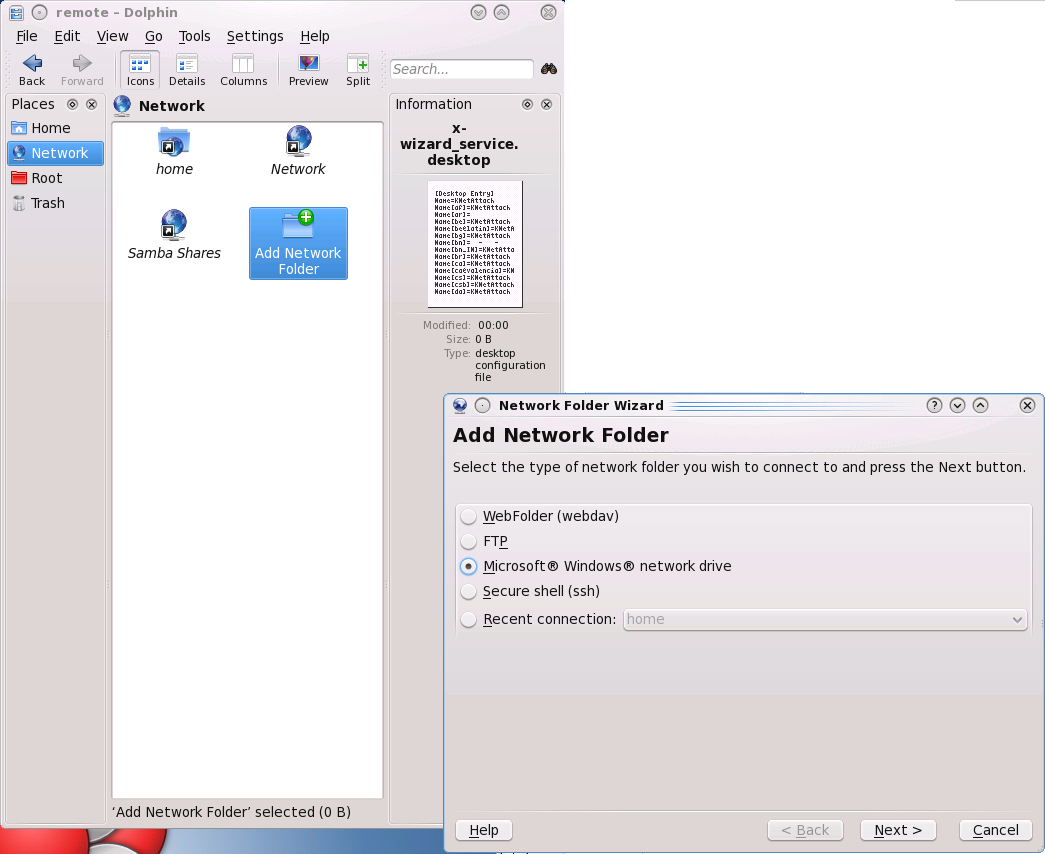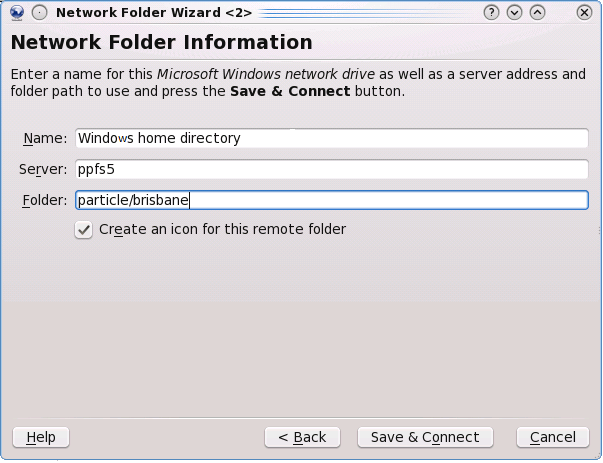Access Central Physics files from Linux
General share information (1)
Each of the techniques below requires a server and share combination to be selected and, for the methods marked INTERNAL, your computer must either be located inside the physics network or connected over the physics VPN.
Note that all of these methods are useful as a way to copy and view files on the network shares but should not be relied upon for long running processes.
INTERNAL or EXTERNAL - Access from outside the department over SFTP
You will need to review, select and configure an appropriate sftp client for your needs. One way to do this is with the "sshfs" fuse utility. This method is the most generally usable and will work for Linux, Windows and OSX shares on all versions of Ubuntu >=10.04.
sshfs connection to create a similar view to the windows Y: drive
Add the following to your $HOME/.ssh/config file
Where yourname should be replaced by your own PHYSICS user name.
Then, create a folder on your Desktop that will hold the contents of the Y: drive
Then, whenever you want to connect:
Your files will now appear in the $HOME/Ydrive directory.
To disconnect wither reboot or stop any processes that are accessing the share and run:
Notable shares made available after using the above method
Your Windows or OSX home directory will then be available at $HOME/Ydrive/home/yourname
Your Central Linux home directory will then be available at $HOME/Ydrive/LinuxUsers/home
Your Particle Linux home directory will then be available at $HOME/Ydrive/LinuxUsers/pplinux/home/yourname
Where yourname should be replaced by your own PHYSICS user name.
INTERNAL - Access to Windows or Linux shares from a departmentally administered Linux platform
If your files are hosted on a Windows or Linux server, and are on a departmentally administered desktop on which you have logged in using your PHYSICS user name and password, you can access the files under the file path /physics/dfs.
Notable places you may want to connect to using this method
To connect to your Windows H: drive or macOS home directory the folder is /physics/dfs/home/yourname.
To connect to your Central Linux Home directory, the folder is physics/dfs/LinuxUsers/home.
To connect to your Particle Linux Home directory, the folder is /physics/dfs/LinuxUsers/pplinux/home/yourname.
Where yourname should be replaced by your own PHYSICS user name.
INTERNAL - Access to the shares from Scientific Linux 6 under under the KDE desktop
With the graphical display open, select the Network icon.
 NWBrowse: Starting the network browser
NWBrowse: Starting the network browser
Select to add a network share of type "Windows Share". The share does not necessarily need to be hosted on windows, but must use the smb protocol. All central home directories are available over smb.
 Add network share
Add network share
Choose the desired server and share name.

Notable places you may want to connect to using this method
To connect to your Windows H: drive or OSX home directory the server is "dc5.physics.ox.ac.uk" and the folder is dfs/home/yourname.
To connect to your Central Linux Home directory, the the server is "dc5.physics.ox.ac.uk" the share name is "dfs" and the folder is dfs/LinuxUsers/home.
To connect to your Particle Linux Home directory, the the server is "dc5.physics.ox.ac.uk" the share name is "dfs" and the folder is dfs/LinuxUsers/pplinux/home/yourname.
Where yourname should be replaced by your own PHYSICS user name.
INTERNAL - Accessing the shares from Ubuntu 12.04 under under the Unity desktop
With the graphical display open, select the "Home Folder" icon.
Choose File-->Connect to server
 File menu in Unity
File menu in Unity
Select "windows share".
Choose the desired server and share name.
To connect to your Windows H: drive or OSX home directory the server is "dc5.physics.ox.ac.uk" the share name is "dfs" and the folder is home/yourname.
 Connecting to a Windows or smb share in Unity
Connecting to a Windows or smb share in Unity
Notable places you may want to connect to using this method
To connect to your Windows H: drive or OSX home directory the server is "dc5.physics.ox.ac.uk" the share name is "dfs" and the folder is home/yourname.
To connect to your Central Linux Home directory, the the server is "dc5.physics.ox.ac.uk" the share name is "dfs" and the folder is LinuxUsers/home.
To connect to your Particle Linux Home directory, the the server is "dc5.physics.ox.ac.uk" the share name is "dfs" and the folder is LinuxUsers/pplinux/home/yourname.
Where yourname should be replaced by your own PHYSICS user name.
INTERNAL - Accessing the shares from a generic Linux machine running gnome
You need the name of the server to connect to from heading (1), in this example I use the smb front end to the central Linux file server, cplxsmb.
To mount DFS from the command line, on GNOME Shell based distributions, run:
On older GNOME systems, use
You may need to create a directory on your local file system wherever you want your files to appear, and activate the gvfs fuse daemon first:
Notable places you may want to connect to using this method:
To connect to your Windows H: drive or OSX home directory (for OSX, this works in Ubuntu >= 14.04 only) the place to connect to is smb://dc5.physics.ox.ac.uk/dfs/home/yourname.
To connect to your Central Linux Home directory, the place to connect to is smb://dc5.physics.ox.ac.uk/dfs/LinuxUsers/home.
To connect to your Particle Linux Home directory, server is "dc5.physics.ox.ac.uk" the folder path is smb://dc5.physics.ox.ac.uk/dfs/LinuxUsers/pplinux/home/yourname.
Where yourname should be replaced by your own PHYSICS user name.
EXTERNAL - Access from outside of the physics department without a password (very experimental/unsupported)
What follows is the instructions to set up sshfs on your Linux laptop using a script to automate the complicated bits. Please note that this is completely experimental and may not be a reliable way to access your files.
http://users.physics.ox.ac.uk/~brisbane/scripts/configure_physics_mounts...
To use it, you need to know your local log-in name on your laptop and your "PHYSICS" user name.
e.g.
bash configure_physics_mounts_ssh brisbanel brisbane
You will be asked for a password for yourname@PHYSICS.OX.AC.UK, which is your password to log on to the "PHYSICS" systems (i.e. the Windows or Linux desktops). It is not stored anywhere on your laptop.
If you have a "PHYSICS" Linux laptop and you use your physics user name and password to log on, then after running the script from the link above your files will appear at the location "/physics" on your laptop (assuming you are on the internet!). You can get to all files in physics via THE PATH /physics/dfs, but there is a shortcut to get to your home or "H:" drive at /physics/home/yourname.
If you don't log in with your "PHYSICS" credentials you will need to run the following command first as your ordinary user every time you log in:
kinit @PHYSICS.OX.AC.UK
If you forget to run this command, you will want to restart autofs to expire the negative cache like this.
The script will probably work on other Linux distributions too, but you will need to install autofs, kerberos5 packages and sshfs. Please add any additional steps taken to the comments on this page if you have used this script on other distributions or bring the laptop to DWB room 661 to discuss.
Categories: Linux | Remote Access | home directories | home directory | sshfs


